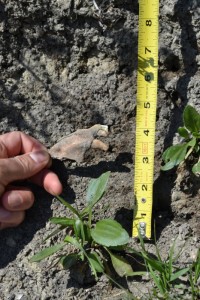Camosun Geoscience environmental technology student Julio Flores made an interesting discovery during a recent field trip with Tark Hamilton, a professor in the department of Chemistry and Geoscience. Flores found half a maxilla of some species of canid, and he was determined to identify the species and age of the bone fragment.
With the help of Hamilton and Annette Dehalt, instructor of Biology and Environmental Technology, Flores managed to contact several relevant experts. After a month of meetings and a subsequent field trip to the site of discovery, it was determined that the fragment is most likely from an extinct Salish Wool Dog, a breed the Salish First Nations people kept from approximately 9,000 to 300 years ago.
Flores will present his find as a Poster Paper Project at the National Association of Geoscience Teachers’ Conference on June 15.
“It is so cool,” says Flores. “I’m so excited with this. It’s taking me so far away from student life, and this is what I want to do.”

Grant Keddie, curator of archaeology at the Royal BC Museum, has headed many archaeological digs in Victoria. He and other experts were able to compare Flores’ find with catalogued fragments, and significant similarities were found. “Early domestic dogs are characterized by an overall reduction in size relative to wolves, as well as some closely spaced or absent teeth,” says Keddie.
Both characteristics are clearly seen in the bone fragment that Flores found. Keddie and the other experts Flores contacted independently identified the fragment as one possibly from a Salish Wool Dog.
“The dogs were kept mainly for the production of wool from its thick, soft inner coat,” says Keddie. “It would have resembled a cross between a small dog and a version of a Northern Spitz.”
Hamilton says that he is glad to be able to mentor a student in the scientific process and adds that he is excited by Flores’ recent discovery.
“Students find neat things, and what a unique opportunity to let students participate at a beginning level,” says Hamilton. “The conference will provide him with an opportunity in presenting information in such a way that without being at the site where the fossil was found you can put people at the cliff and in the context. That’s the kind of writing I would like to foster.”
Not every first-year student gets to have an experience like this, and Flores understands the interest and time Dehalt and Hamilton have put into this project.
“If it wasn’t for them,” says Flores, “I wouldn’t have gone this far.”

Sorry Steve, missed that in the edited version.
Great story. But it should be pointed out that Julio is an Environmental Technology student who was taking a geoscience course.